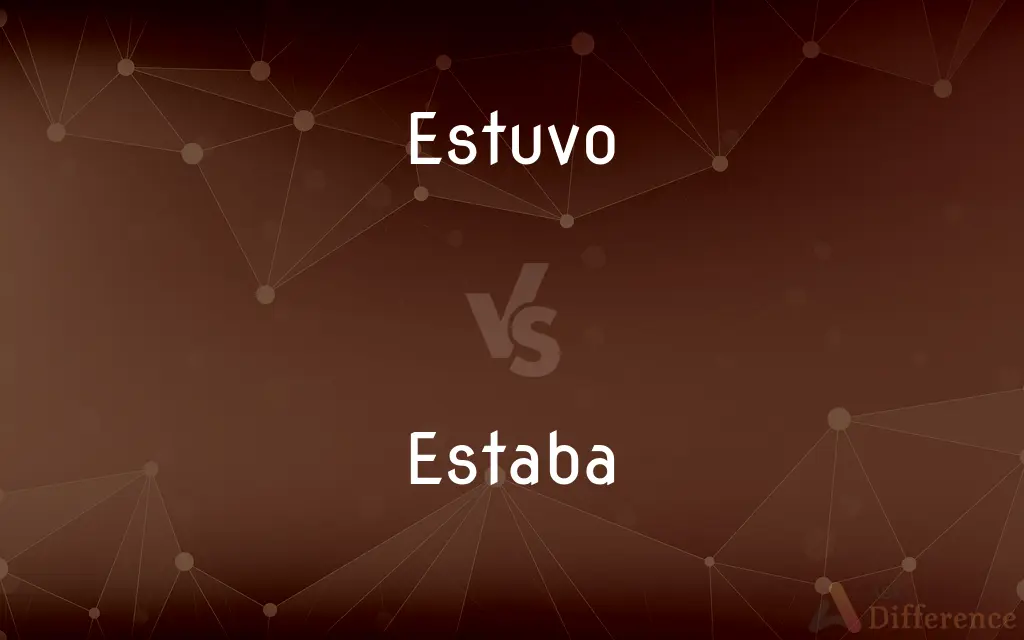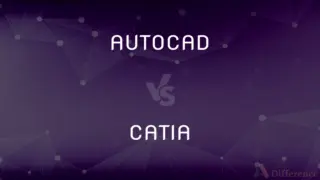Estuvo vs. Estaba — What's the Difference?
By Tayyaba Rehman — Published on January 1, 2024
"Estuvo" is the third person singular past tense of "estar" in the preterite, indicating a completed action. "Estaba" is the same verb in the imperfect, denoting a past action with duration or no defined end.

Difference Between Estuvo and Estaba
Table of Contents
ADVERTISEMENT
Key Differences
"Estuvo" and "Estaba" are both past tense forms of the Spanish verb "estar," meaning "to be" in certain contexts, primarily relating to temporary states or locations. "Estuvo" is used in the preterite tense, which describes actions that have been completed. "Estuvo" provides a sense of finality to an action, suggesting it had a clear end point. For example, "Estuvo en la tienda" means "He/She was at the store" with the understanding that the person is no longer there.
In contrast, "Estaba" is used in the imperfect tense, which often conveys an ongoing action or state in the past without a specific beginning or end. "Estaba" could suggest a habitual action, an ongoing state at a particular time, or an action that was happening simultaneously with another action. For example, "Estaba en la tienda" implies "He/She was at the store," but leaves open the possibility that other actions were taking place or the duration of the stay.
Comparison Chart
Tense
Preterite
Imperfect
Connotation
Completed action
Ongoing/duration without defined end
Use Case
Single events, specific moments
Habitual actions, background settings
ADVERTISEMENT
Time Reference
Definite, clear end point
Indefinite, no clear beginning or end
Example
"Estuvo enfermo ayer." (He was sick yesterday.)
"Estaba enfermo cuando lo llamé." (He was sick when I called him.)
Compare with Definitions
Estuvo
Definite Time
Estuvo en la fiesta anoche. (He/She was at the party last night.)
Estaba
Background Setting
Estaba oscuro en la habitación. (It was dark in the room.)
Estuvo
Completed Action
Estuvo lloviendo hasta las seis. (It had been raining until six.)
Estaba
Imperfect Tense
Estaba nevando toda la mañana. (It was snowing all morning.)
Estuvo
Singular Event
Estuvo cerrada la tienda el domingo. (The store was closed on Sunday.)
Estaba
No Defined Endpoint
Estaba cansado pero seguía trabajando. (He/She was tired but kept working.)
Estuvo
Clear Endpoint
Estuvo trabajando hasta tarde y se fue a casa. (He/She worked until late and went home.)
Estaba
Ongoing Past Action
Estaba leyendo cuando sonó el teléfono. (He/She was reading when the phone rang.)
Estuvo
Preterite Tense
Estuvo aquí hace un momento. (He/She was here a moment ago.)
Estaba
Habitual Past Action
Estaba en el gimnasio todos los días. (He/She used to be at the gym every day.)
Common Curiosities
Can "Estuvo" be used for habitual actions?
No, "Estuvo" is for singular, completed events.
What is "Estuvo" used for?
It's used to describe completed actions or specific instances in the past.
When should I use "Estaba"?
When describing past actions without a clear end or for habitual past actions.
Does "Estuvo" refer to a precise moment?
Yes, it indicates a clear, defined moment.
What if I don't know when the action ended?
"Estaba" would be more appropriate in such cases.
Are there instances where both "Estuvo" and "Estaba" could be correct?
Yes, depending on the context and the speaker's perspective.
Which form is used for interrupted actions in the past?
"Estaba" is used when indicating an action that was interrupted.
Is "Estuvo" more definite than "Estaba"?
Yes, it conveys a definite completion of an action.
Does "Estaba" imply that the action is still happening?
Not necessarily; it indicates the action was ongoing in the past.
Is "Estuvo" always about the past?
Yes, it's a past tense form of "estar."
Would I use "Estuvo" for actions with a clear start and finish?
Yes, that's the appropriate use of "Estuvo."
Can "Estaba" be used to imply the action might continue?
Yes, it doesn't specify whether the action continued or not.
Can "Estaba" be used to set a scene?
Yes, it's often used to describe the setting or ongoing background actions.
Which form aligns with the English simple past tense?
"Estuvo" often aligns with the simple past tense in English, though context matters.
Is "Estaba" suitable for storytelling?
Yes, especially when describing past scenarios or habitual actions.
Share Your Discovery

Previous Comparison
AUTOCAD vs. CATIA
Next Comparison
DDL in DBMS vs. DML in DBMSAuthor Spotlight
Written by
Tayyaba RehmanTayyaba Rehman is a distinguished writer, currently serving as a primary contributor to askdifference.com. As a researcher in semantics and etymology, Tayyaba's passion for the complexity of languages and their distinctions has found a perfect home on the platform. Tayyaba delves into the intricacies of language, distinguishing between commonly confused words and phrases, thereby providing clarity for readers worldwide.















































